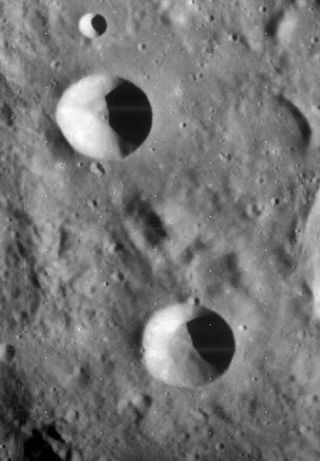
The Great Library of Alexandria in Alexandria, Egypt, was one of the largest and most significant libraries of the ancient world. The Library was part of a larger research institution called the Mouseion, which was dedicated to the Muses, the nine goddesses of the arts. The idea of a universal library in Alexandria may have been proposed by Demetrius of Phalerum, an exiled Athenian statesman living in Alexandria, to Ptolemy I Soter, who may have established plans for the Library, but the Library itself was probably not built until the reign of his son Ptolemy II Philadelphus. The Library quickly acquired many papyrus scrolls, owing largely to the Ptolemaic kings' aggressive and well-funded policies for procuring texts. It is unknown precisely how many such scrolls were housed at any given time, but estimates range from 40,000 to 400,000 at its height.

Year 405 (CDV) was a common year starting on Sunday of the Julian calendar. At the time, it was known as the Year of the Consulship of Stilicho and Anthemius. The denomination 405 for this year has been used since the early medieval period, when the Anno Domini calendar era became the prevalent method in Europe for naming years.
Hypatia was a neoplatonist philosopher, astronomer, and mathematician who lived in Alexandria, Egypt, then part of the Eastern Roman Empire. She was a prominent thinker in Alexandria where she taught philosophy and astronomy. Although preceded by Pandrosion, another Alexandrine female mathematician, she is the first female mathematician whose life is reasonably well recorded. Hypatia was renowned in her own lifetime as a great teacher and a wise counselor. She wrote a commentary on Diophantus's thirteen-volume Arithmetica, which may survive in part, having been interpolated into Diophantus's original text, and another commentary on Apollonius of Perga's treatise on conic sections, which has not survived. Many modern scholars also believe that Hypatia may have edited the surviving text of Ptolemy's Almagest, based on the title of her father Theon's commentary on Book III of the Almagest.

Year 335 (CCCXXXV) was a common year starting on Wednesday of the Julian calendar. At the time, it was known as the Year of the Consulship of Constantius and Albinus. The denomination 335 for this year has been used since the early medieval period, when the Anno Domini calendar era became the prevalent method in Europe for naming years.
Theon of Alexandria was a Greek scholar and mathematician who lived in Alexandria, Egypt. He edited and arranged Euclid's Elements and wrote commentaries on works by Euclid and Ptolemy. His daughter Hypatia also won fame as a mathematician.

Sosigenes is a lunar impact crater on the west edge of Mare Tranquillitatis. Its diameter is 17 km. It was named after ancient Greek astronomer Sosigenes of Alexandria. It lies to the east of the large walled plain Julius Caesar. The crater rim has a high albedo, making it relatively bright. It has a small central rise at the midpoint of the floor.

Theon Junior is a lunar impact crater that is located just to the west-southwest of the crater Delambre. It forms a matching pair with Theon Senior, only a couple of crater diameters to the north-northwest. The crater is circular and bowl-shaped, with a small floor at the bottom of the high, sloping interior walls. It is named for Theon of Alexandria, a 4th-century Greek astronomer and mathematician. The crater is from the Eratosthenian period, which lasted from 3.2 to 1.1 billion years ago. It is 17 kilometers in diameter and the difference in height at its rim and its deepest part is 3,580 meters.

Theon Greyjoy is a fictional character in the A Song of Ice and Fire series of fantasy novels by American author George R. R. Martin, and its television adaptation Game of Thrones. Theon is the youngest son and heir of Balon Greyjoy, taken as a ward by Lord Eddard Stark following Balon's failed rebellion. Theon's complex and troubled relationship with both his family and his captors is central to the character's arc throughout the novels and its television adaptation.
Theon of Smyrna was a Greek philosopher and mathematician, whose works were strongly influenced by the Pythagorean school of thought. His surviving On Mathematics Useful for the Understanding of Plato is an introductory survey of Greek mathematics.
Theon may refer to:
Sosigenes was an Ancient Greek astronomer. According to Pliny the Elder's Natural History 18.210–212, Julius Caesar consulted him while he was designing the Julian calendar.
Sosigenes the Peripatetic was a philosopher living at the end of the 2nd century AD. He was the tutor of Alexander of Aphrodisias and wrote a work On Revolving Spheres, from which some important extracts have been preserved in Simplicius's commentary on Aristotle's De Caelo.
Apollodorus of Seleucia, or Apollodorus Ephillus, was a Stoic philosopher, and a pupil of Diogenes of Babylon.

Alexandria is a 2009 historical mystery crime novel by Lindsey Davis and the 19th book in her Marcus Didius Falco series. Set in Egypt and Ancient Rome, the novel stars Marcus Didius Falco, informer and imperial agent. The title refers to the setting where the deaths occur.
Theon of Alexandria was a grammarian who taught at Rome in the reigns of the emperors Augustus and Tiberius. He succeeded Areius in this role, and was succeeded by Apion. He was the son of the grammarian Artemidorus of Tarsus and the head of the school at Alexandria.
Papyrus Oxyrhynchus 119 is a letter from a child, written in Greek and discovered in Oxyrhynchus. The manuscript was written on papyrus in the form of a sheet. The document was written in the 2nd or 3rd century. Currently it is housed in the Bodleian Library.
Adolphe Rome was a Belgian classical philologist and science historian who was particularly concerned with the ancient history of astronomy.